Charles Merrick
Captain, Company G
Charles C. Merrick was born in Munson, Massachusetts on April 11, 1824. He became a teacher and went south to teach. He became a successful builder and contractor in Memphis, Tennessee but had to leave his success behind upon the outbreak of the Civil War. He went to Chicago where the Fifty-First Illinois was being formed. He joined Captain George Wentz's Company G. Although he joined as a private, at formal muster-in of the regiment, Merrick ranked as first sergeant of the company. In January and February 1862, while the regiment was in training at Camp Douglas, Merrick earned extra pay as a clerk in the camp hospital.
George Wentz, the captain of Company G, resigned in mid-1862 and the officers of the company each shuffled up one level of seniority to fill the cascading vacancies. Formally, Merrick's resultant promotion to the second lieutenancy of the regiment was dated June 28, 1862. Merrick was promoted to captain of Company G (he was never first lieutenant) on December 18, 1862, but that date was later altered to officially begin his captaincy on October 28, 1862.
The Attack on the Picket Force, November 5 1862. In September of 1862, the Fifty-First and its brigade, along with a large Federal force, hurried to Nashville to keep it from falling back into Confederate hands. For two months, the Federal force expected to be attacked. On November, 5, 1862, Confederate forces attacked the Federal picket lines where the left wing of the regiment was on duty. Merrick was in charge of the picket force. The attack came at two o'clock in the morning. The regimental journal record that Companies F and G were pushed back and driven from their posts. Merrick rallied his men and brought them back to their post about daylight. The Confederate attack began again. The journal said, "The Rebels brought up artillery at the same time attacking again in several different places. Our forces were all out and the different forts had opened fire. We all supposed that the long promised attack had at last commenced but the enemy got no nearer to us than our picket line. We had seven wounded, some of them seriously. The enemy left several of their dead upon the field." The Cincinnati Daily Commercial reported the events, timed a little bit differently according to their watch—conflated here, unpacked there—"About midnight the pickets were attacked on the Gallitin, Murfreesboro and Franklin Turnpikes, and skirmishing was continued at these points until daylight, the pickets at some places gradually falling back upon the reserves. At daylight the enemy opened upon us on the Murfreesboro Pike with artillery. Part of the 51st Illinois were on picket there, and the remainder of the regiment went to their support. A short but severe skirmish ensued, resulting in the repulse of the enemy, with a loss of several killed and wounded... The rebels were seen during the fight gathering up their dead and hauling them off in a common road wagon. The 51st had four slightly wounded, and three severely in their limbs. They also have two missing, viz: Samuel Wagstaff and Patrick Quigley" (November 12, 1862). [Wagstaff and Quigley were both soon quickly paroled, spent time at the parole camp in Columbus, Ohio while waiting prisoner exchange, and neither ever returned to active service with the regiment. Quigley was discharged for disability; Wagstaff deserted from parole camp. Michael Murphy of Company G later died of his wounds. He's buried at the Nashville National Cemetery.] In a November 26, 1862 letter to the Illinois adjutant general Lieutenant Colonel Luther Bradley, then commanding the Fifty-First at Nashville, wrote, "Lieut. Merrick is entitled to the command of his company for the gallantry with which he repulsed an attack of 400 rebels on the picket post held by his company on the morning of the 5th inst—inflicting severe punishment on them, with a loss of but 3 wounded to himself."
Falling Ill. But, as Merrick's efficiency and courage worked for his success as an officer, physical illness worked against him. In February and March 1863, shortly after the Battle of Stone's River, Merrick was troubled by some form of bowel hemorrhage—"not from hemorrhoids", said his doctor; it was serious enough to "render him unfit for service in the field." Surgeon Francis W. Lytle of the Fifty-First recommended Merrick's discharge from the service, but Merrick refused "hoping he would recover". But, it was not to be so. In August 1863, Lytle (by then with the Thirty-Sixth Illinois) reported that Merrick "still finds himself laboring under the same malady. My opinion is a longer continuance in the service will endanger his life." Thomas Magee, regimental surgeon of the Fifty-First, agreed, writing that Merrick was not even fit for the Invalid Corps because of his "broken down condition". By letter of August 17, 1863, Merrick tendered his resignation. It was formally accepted on September 12, 1863.
[Below, Front Gate of Ivy Hill Cemetery, Malcom, Iowa, where Merrick is buried.]
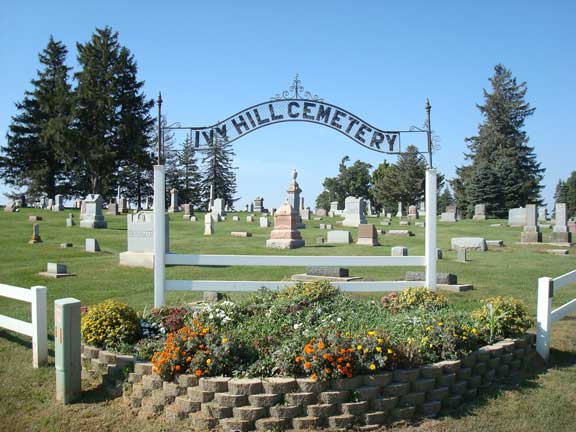 |
Chickamauga to Chicago. Merrick's service to the Fifty-First did not quite end with his resignation—he had yet to help at the Battle of Chickamauga. In the pension process for one of his Company G men, Merrick deposed, "That on the morning that this battle began acceptance of his resignation was handed him and he was ordered out of the lines, that he started for Chattanooga with some army teams - that firing soon thereafter commenced - that before reaching Chattanooga, an officer on staff of Genl. Rosecrans with whom he was acquainted passed, giving the information that a terrible battle was in progress and that the 51st was badly cut up - that he then left the wagons and started to rejoin the regiment reaching it about evening and remaining with it till after intrenchments were completed around Chattanooga. Merrick helped men who were being taken to the rear to hospitals on the 19th and later after Chattanooga had been secured at hospitals in that city. Only then did Merrick recommence his journey away from the front toward Chicago. He carried one of the regiment's flags with him, from the Chickamauga battlefield to Chicago. The Chicago Tribune of October 2, 1863 reported that Merrick arrived the day before from Chattanooga, where the regiment "participated in one of the most noted and earnest battles of the war. By him we were shown the remnants of the flag of the 51st—tattered and torn into shreds by the shower of iron hail, till it more nearly resembles a handful of silk rags than a regimental flag. The flag speaks volumes."
After the War. Back in Chicago, Merrick turned once again to business pursuits. He married Emma Parsons, the daughter of a Massachusetts family. Her parents were Henry and Louise Parsons, who migrated to Illinois in 1860s and on to middle Iowa in the 1870s. Merrick and Emma married in 1866 and lived in Chicago. Merrick became wealthy from his pursuits in both real estate and mining. Charles and his brother George Merrick purchased the Peru Coal Company soon after the war; Charles was president of the company and tended to day-to-day operations. The 1870 census shows Charles and Emma living in Chicago's Fourth Ward. Interestingly, Captain Theodore Brown of Company D of the Fifty-First was a close neighbor; Brown, too, was prospering—as a hardware manufacturer. The Peru Coal Company incorporate and did well financially. In 1873, the assessed value of the company was $520,000. As points of comparison, the Pullman Car Company was assessed at $2,000,000 and the Union Stockyards at $1,000,000. There was only one mining company in Illinois that had a higher assessed value than the Merricks' company.
Around 1890, Merrick's fortunes failed. We can't find out why exactly.
In 1893, Charles and Emma visited Emma's family at Malcom, Iowa. While there Merrick fell ill and died on June 23, 1893. He was buried in Malcom's Ivy Hill Cemetery. Emma lived on in Malcom until 1932. She became a painter and made money from it. The 1911 History of Poweshiek County (see below) said, "Mrs. Merrick is an artist of considerable note, having taken up the study of water color and china painting in childhood. She was one of the first china painters in Chicago, and after the loss of her husband's property devoted her attention to art as a business proposition, from which she reaped substantial financial returns. She painted the picture called the 'Cyclone' for the Iowa State College, and has many beautiful specimens of her skill in her home."
Emma died by fire in the home where she lived with her sister in Malcom. On Memorial Day, 1932 she put papers into her cook stove. Her apron caught fire. Her obituary went on, "In her alarm and confusion she ran out of doors, the flames caught in her clothing and before help could reach her she had been terribly burned." Emma was over 90 years old at the time of her death. |
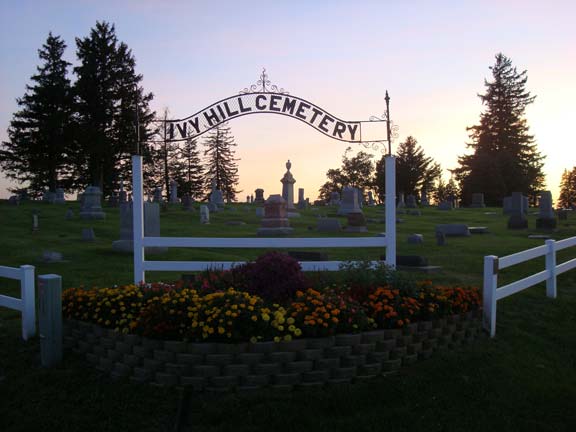 |
From Parker's 1911 History of Poweshiek County Iowa (full reference below):
The second daughter in the Parsons family is Emma E., who in 1866 became the wife of Charles C. Merrick, a native of Munson, Massachusetts, where he was born on the 11th of April, 1824. He was reared and educated in his native city and later went south as a school teacher, being connected with that profession for several years. Subsequently he became a contractor and builder at Memphis, Tennessee, in which line of activity he was most successful until the outbreak of the Civil war, when he lost very heavily. He then went to Chicago, where he enlisted as a private of the Fifty-first Illinois Volunteer Infantry in 1861, under command of Captain Wentz. He served throughout the entire period of hostilities and was promoted to the rank of captain, in which position he was serving when he was wounded at the battle of Chickamauga. He was breveted major March 13, 1865. While Mr. Merrick was at the front his half- brother, Jacob B. Merrick, an extensive cotton manufacturer, operating the Merrick Cotton Mills of Thorndike, Massachusetts, passed away, leaving him a handsome fortune of two hundred and fifty thousand dollars. After the close of the war he went to Peru, Illinois, where, in connection with his brother, George Merrick, he purchased the Peru Coal Company, of which he became president. He was successfully engaged in the conduct of this business for many years, but shortly before his death suffered the loss of his property. He, passed away on the 23d of June, 1893, in Malcom township, while on a visit here. Mrs. Merrick is an artist of considerable note, having taken up the study of water color and china painting in childhood. She was one of the first china painters in Chicago, and after the loss of her husband's property devoted her attention to art as a business proposition, from which she reaped substantial financial returns. She painted the picture called the "Cyclone," for the Iowa State College, and has many beautiful specimens of her skill in her home. |
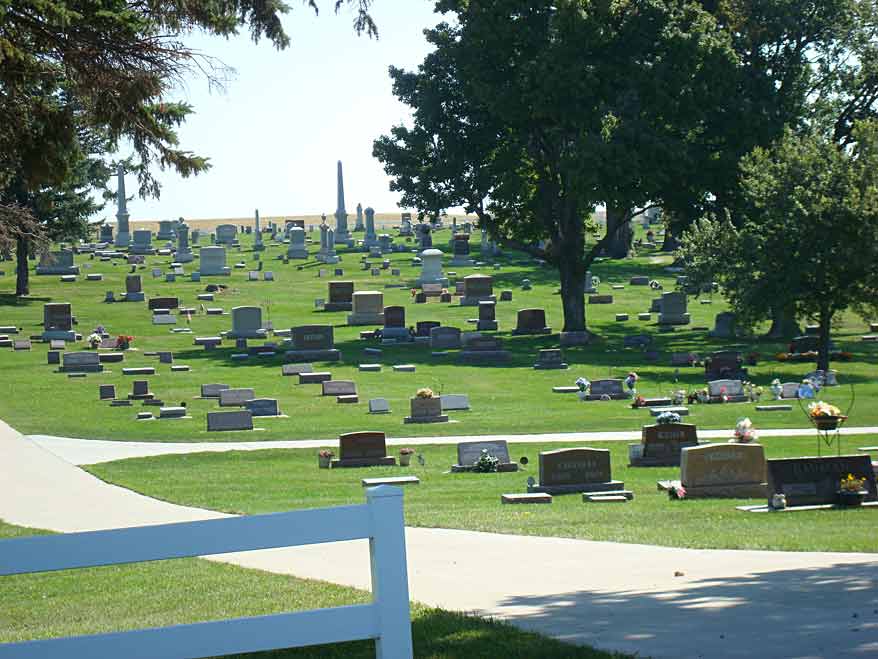 |
Ivy Hill Cemetery from the entrance at the west, looking east toward Merrick's grave, which lies somewhere between the two obelisks in the distance. |
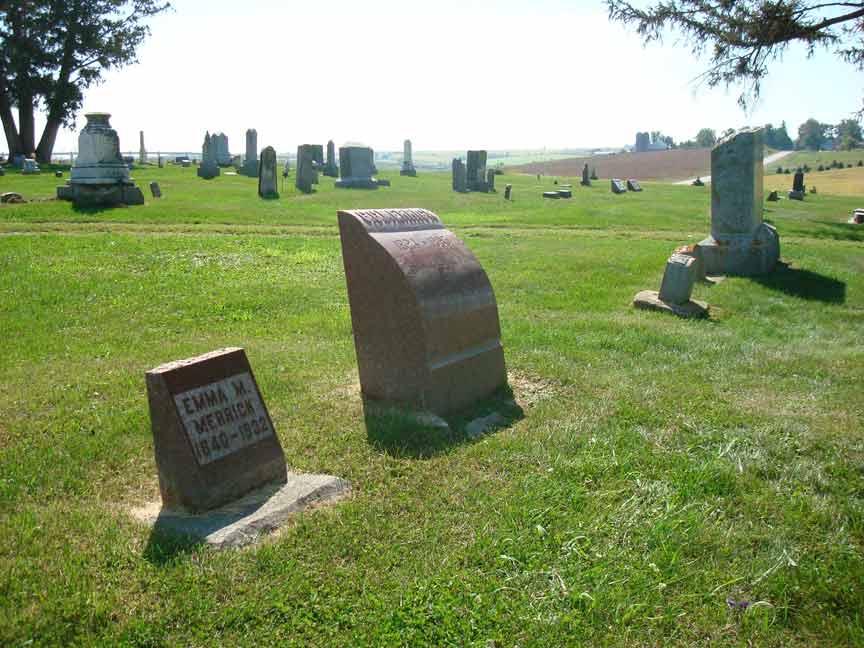 |
Emma Merrick's gravestone and next to it Charles Merrick's odd-shaped red granite stone. The camera looks southeast. The road disappearing south over the hill is US Highway 63, about to junction with Interstate 80. It runs north-south. Malcom lies over the hill. |
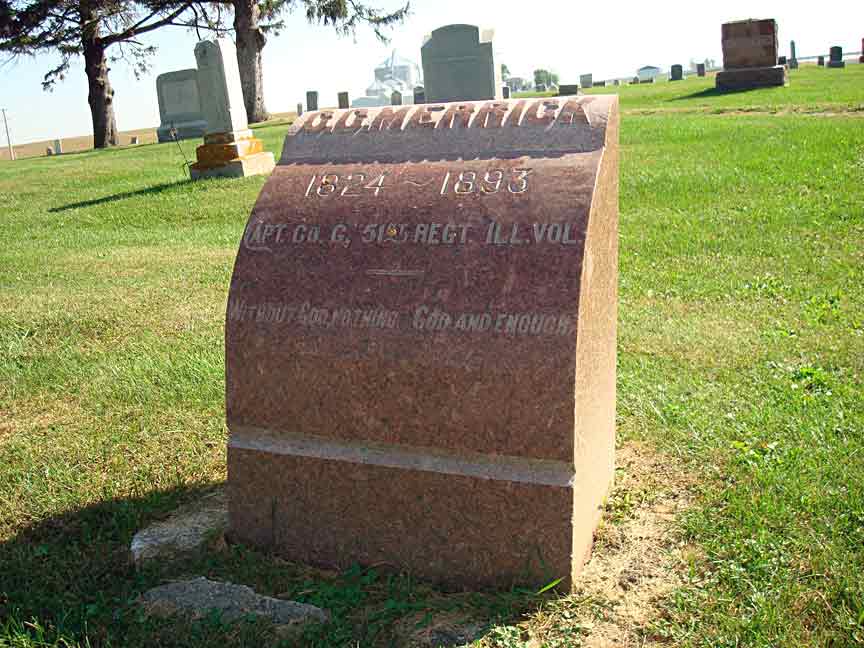 |
Merrick's stone close up in morning light. |
Sources:
Many thanks to Denise Baustian, keeper of the Ivy Hill records, for locating Merrick's grave and for finding Emma Merrick's obituary in the holdings of Grinnell, Iowa's Stewart Library.
Charles Merrick, Compiled Service Record, Records of the Adjutant General's Office, 1780's-1917, Record Group 94, National Archives and Records Administration, Washington, D.C.
Fifty-First Illinois Infantry, Muster an Descriptive Rolls, RS 301.020, Illinois State Archives, Springfield, Illinois.
L.F. Parker, History of Poweshiek County Iowa, A Record of Settlement, Organization, Progress and Achievement, 2 Volumes, Chicago: The S. J. Clarke Publishing Co., 1911, Vol 2.
Reports of Cases at Law and In Chancery Argued and Determined in the Supreme Court of Illinois, Volume 61, September Term 1871 (Springfield, 1874).
Biennial Report of the Auditor of Public Accounts, to the Governor of Illinois, December 18, 1872, Springfield, 1862.
United States of America, Bureau of the Census. Ninth Census of the United States, 1870. Washington, D.C.




